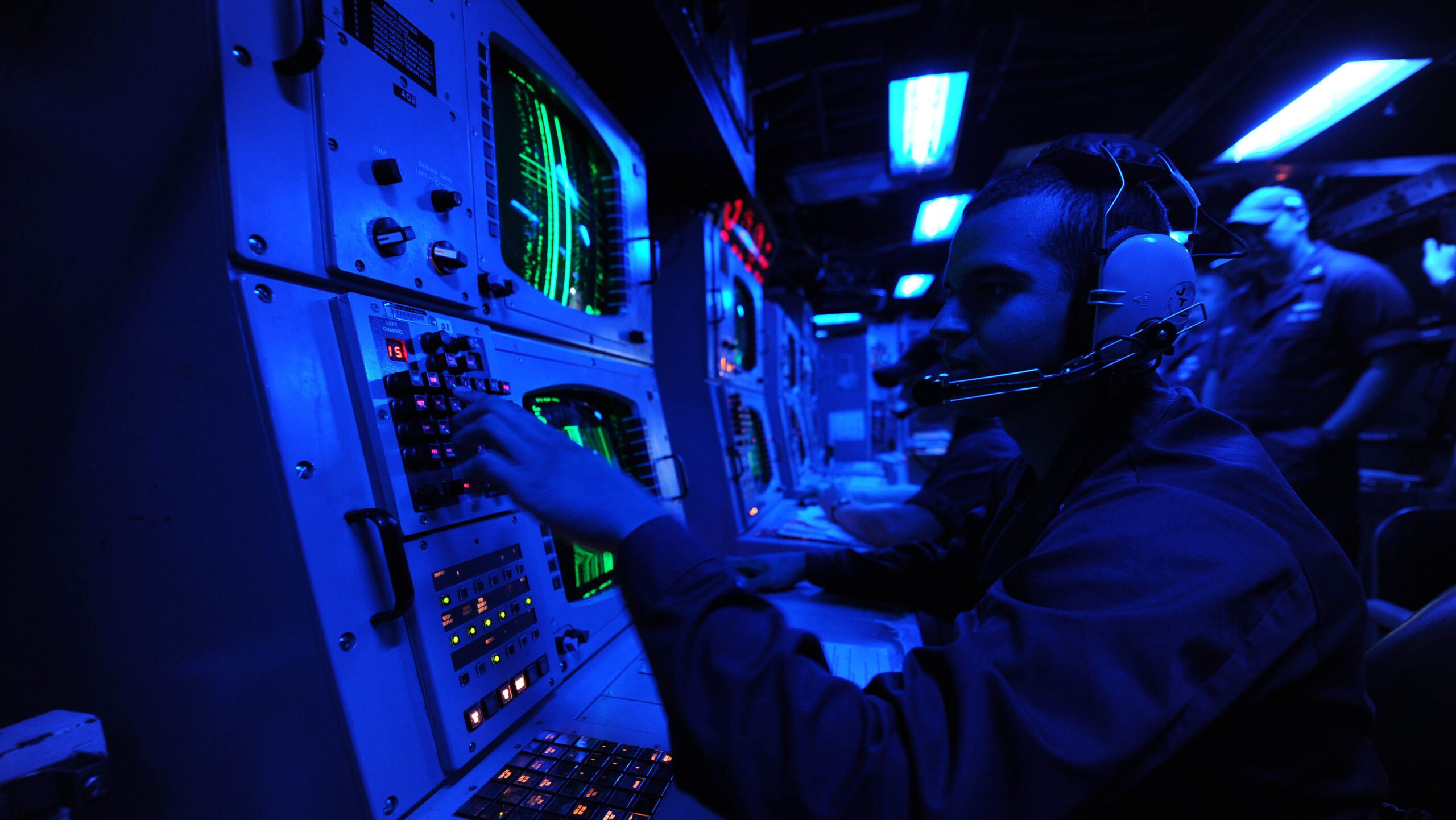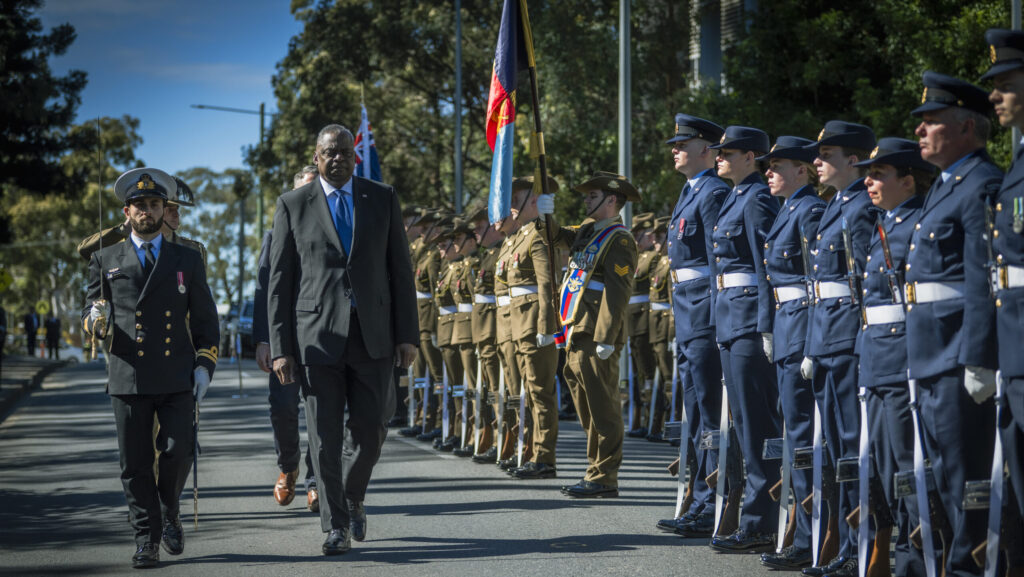
A Navy passive-sonar operator listens for activity aboard the USS Ramage. (US Navy photo by Jacob D. Moore)
WASHINGTON — You’ve seen it in too many movies. Passive-sonar operators wearing headphones strain to hear faint traces of an enemy submarine. The crew of the hunted sub go quiet, holding their breath, as active sonar pings against the hull, searching, searching, searching….
But today, anti-submarine warfare is a battle of machines. Artificial intelligence algorithms piece together the acoustic clues from scores of scattered sensors that share data over long-range networks. And tomorrow, experts told Breaking Defense, new technologies — from robotic scouts to quantum sensing — threaten to rend the veil of stealth and expose subs to attack.
Whoever masters these technologies could gain a vital advantage in naval warfare, one relevant to the Arctic, NATO’s Baltic and Black Sea flanks, and above all the US-China contest across the vast Pacific. So research into AI, robotics, quantum science, and anti-submarine warfare are becoming increasingly important and increasingly intertwined for the US and its allies.
“The Navy is committed to leveraging cutting-edge technologies,” a service spokesperson told Breaking Defense in a carefully non-committal statement. “We understand the significance of quantum technologies including quantum sensing, quantum timing, and artificial intelligence for submarine detection and anti-submarine warfare in the undersea domain, among other applications.”
It’s safest to assume the same is true for China’s aggressively modernizing — and increasingly aggressive — PLA Navy as well. Besides its oft-cited goal of being able to forcibly “reunify” with Taiwan by 2027, China aims to be the word’s leader on AI by 2030 and is arguably ahead in some niches of quantum science, like theoretically unhackable networks using so-called quantum key distribution.
At least for now, the advantage — particularly in quantum tech — is with the AUKUS triple alliance of Australia, the United Kingdom, and the United States, argued Arthur Herman, director of the Quantum Alliance Initiative at the Hudson Institute.
“This is a tech race where the AUKUS countries can have an asymmetric advantage over China, if they integrate their quantum R&D to arrive at a series of prototypes for T&E [testing and evaulation] at sea,” Herman told Breaking Defense. “Like the advent of sonar, the advent of quantum sensing has the potential to revolutionize submarine warfare — whether we’re talking manned or unmanned systems.”
RELATED: Navy tests ‘tactical’ employment of unmanned ships in months-long exercise
While manned subs get the glory, unmanned underwater vehicles (UUVs) are in widespread use already, added Herman’s Hudson colleague, former submariner and Navy strategist Bryan Clark.
“UUVs are very mature and some of the US Navy’s UUVs (like the Remus 100 and 600 series) have been in service for 20 years,” Clark told Breaking Defense. “The latest versions are highly automated and as we addressed in our recent study for the ADF [Australian Defense Force], the time a UUV could operate without outside help can be as long as weeks or months, depending on how sophisticated the task is. … In our work with the ADF, uncrewed systems is by far the most prominent new technology they are pursuing.”
Today, most of these underwater drones are awkward and slow: The Remus 600 series manages at most five knots, not quite six miles per hour, compared to over 25 knots/28 mph for a Virginia-class nuclear-powered nuclear attack sub. But being smaller, cheaper, and unrestricted by human endurance, they can “flood the zone” with sensors, watching and waiting until they spot something their algorithms flag as interesting, then report to human overseers. In the future, new kinds of quantum sensors and sophisticated AI signal processing could make these swarms of robo-subs much harder to evade.

Defense Secretary Lloyd Austin is formally welcomed to Australia by Deputy Prime Minister Richard Marles in July, 2023. (DoD photo by Chad J. McNeeley)
Allies Advance In Anti-Submarine Warfare
Just last week two key Pacific allies, Australia and Japan, announced an unprecedented agreement to collaborate on research “to enhance strategic capabilities in robotic and autonomous systems for undersea warfare.” Not long before, on Dec. 1, the AUKUS alliance announced their latest slate of research, development, and experimentation initiatives, ranging from industrial base investments to space-monitoring radar. Five of these projects explicitly targeted the undersea domain:
- unmanned mini-submarines, small enough to be launched from torpedo tubes — including on Australia’s future US-designed subs — for both strike and scout missions;
- AI algorithms on the mainstay US and Australian maritime patrol plane, the P-8A Poseidon, and unspecified other systems to process the masses of data collected by air-dropped sonar buoys;
- “integrated trilateral experiments and exercises” for autonomous systems writ large, both unmanned craft and automated data-sharing;
- AI/machine learning for a host of purposes, including “precision targeting, and intelligence, surveillance, and reconnaissance … across land and maritime domains”; and
- “Quantum Positioning, Navigation, and Timing,” which uses miniaturized quantum clocks and sensors to substitute for GPS. That’s valuable to air and surface forces in wartime — when GPS is often jammed — and to submarines all the time, because the GPS signal can’t penetrate underwater. (Neither can radar or radio, which all use the same kind of electromagnetic waves.)
While Australia’s purchase of US nuclear-powered attack subs is the big-budget, high-profile “Pillar I” of AUKUS, these new initiatives belong to the broader and, in the long term, equally important “Pillar II.” This is an R&D collaboration across eight “advanced capabilities,” of which two are directly relevant to the new undersea warfare “quantum technologies” and “artificial intelligence and autonomy.”
Quantum, in particular, is a rapidly emerging (and poorly understood) technology that exploits the paradoxical behavior of subatomic particles. It’s also a scientific arena where Australia, while only the world’s 12th largest economy, punches well above its weight.
In fact, in terms of quantum innovation per capita, “they would probably be number one,” said Celia Merzbacher, executive director of the Quantum Economic Development Consortium.
“There was a very interesting assessment done by the Australian Strategic Policy Institute [calculating] ‘highly cited publications’,” she told Breaking Defense. “It shows the US and China are number one and number two in every quantum area” — unsurprisingly — but Australia, Britain, and other US allies dominate the top five in most subcategories of quantum research.
RELATED: ‘Off to the races’: DARPA, Harvard breakthrough brings quantum computing years closer
For now, quantum is largely happening in the lab, not on board submarines. “Most of the effort is happening at a basic science level between defense research organizations like DSTG in Australia and NRL, DARPA, etc. in the US,” said Clark. But while advanced applications like code-breaking quantum computers may be a decade or more away, one application is already here: timekeeping.
By keeping time, experts say, literally “million of times better“ than the atomic clocks from which they evolved, quantum clocks allow sensors to make much more accurate measurements. That’s helpful for all sorts of purposes, notably for inertial navigation systems, which “drift” subtly from their true course over time and require constant error-correction: the more frequent, the better. Inertial navigation is important, in turn, because it works when GPS is not available — for example underwater.
The next evolution of quantum science is sensing, because quantum phenomena can be exquisitively sensitive to outside forces. By studying just how the subatomic particles change their behavior, observers can deduce what external influence is changing it. So, in theory, a quantum sensor could pick up all sorts of phenomena that sonar cannot, from magnetic fields to the subtle gravitational pull of a large vessel, such as a submarine.
But that sensitivity is a double-edged sword, because, by definition, more sensitive sensors pick up more of everything — including false positives. The same problem applies to some other types of sensors, notably magnetic anomaly detection (MAD). First deployed in World War II, MAD proved so sensitive it picked up scores of up shipwrecks as it sought the subtle distortions in the earth’s magnetic field created by a sub’s metallic hull, limiting its effective range, even in modern versions, to less than a mile. Similarly, some forms of passive sonar — which listens quietly for enemies, rather than actively sending out a “ping” — struggle to sort out subs from whales and heavy weather.
In all these cases, however, there’s a potential solution: applying powerful pattern-recognition algorithms to churn through the mass of data, throw out false positives, and highlight the likely contacts for the human operator to investigate. Nowadays, those algorithms use artificial intelligence.
“AI algorithms have been used in ASW [anti-submarine warfare] prosecutions for about a decade,” said Clark. “The leading edge of ASW processing algorithms is increasingly focused on pulling weak signals out of background noise.”
The problem in sub-hunting isn’t a shortage of high-quality sensors, argued Sidharth Kaushal, a naval expert at Britain’s Royal United Services Institute. Rather, it’s how to sort through more and messier data than the human mind can manage.
“We’ve had sensors that have a great deal of fidelity for a very long time. It’s about sifting the signal from the noise,” Kaushal told a recent media roundtable. “That’s typically very tasking for the individuals involved, [but] machine learning can considerably simplify the process.”
That means old sensors once deemed too hypersensitive for human operators to handle — or new ones, like quantum detectors — become more and more usable in real-life missions as AI advances. And, of course, AI is advancing at a staggering rate. Add submariners to the long list of professions that need to worry about the rise of the machines.












